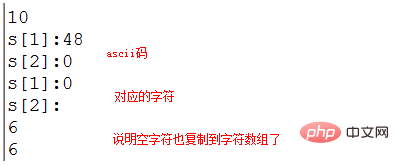What is the end mark of a string in C language?
C语言中字符串的结束标志是【'\0'】。C语言中没有专门的字符串变量,通常用一个字符数组来存放一个字符串,字符串总是以【'\0'】作为结束符。

'\0'就是8位的00000000,因为字符类型中并没有对应的这个字符,所以这么写。'\0'就是 字符串结束标志。
'\0'是转译字符,意思是告诉编译器,这不是字符0,而是空字符。空字符\0对应的二进制为00000000,而数字0为00110000。
(相关视频推荐:java视频教程)
原来,在C语言中没有专门的字符串变量,通常用一个字符数组来存放一个字符串。字符串总是以'\0'作为串的结束符。因此当把一个字符串存入一个数组时,也把结束符 '\0'存入数组,并以此作为该字符串是否结束的标志。有了'\0'标志后,就不必再用字符数组的长度来判断字符串的长度了。
说明:
把一个字符串赋值给数组:u8 str1[]={"cxjr.21ic.org"}; 实际上数组str1在内存中的实际存放情况为:c x j r . 2 1 i c . o r g '\0' 。这后面的'\0'是由C编译系统自动加上的。所以在用字符串赋初值时一般无须指定数组的长度, 而由系统自行处理。把字符数组str1中的字符串拷贝到字符数组str2中。串结束标志'\0'也一同拷贝。
个案:
1、当数组长度不够。假设我们指定了数组长度,如:u8 str1[13]={"cxjr.21ic.org"}; 由于字符组str1的长度为13,所以后面的信息会丢失,即'\0'丢失。
2、如果在给数组赋值时,把每个字符单独用引号括起来。也会丢失'\0'。如:u8 str1[]={'c','x','j','r','.','2','1','i','c','.','o','r','g'}; 如果希望数组以'\0'结束,则可以写成以下三者之一:
u8 str1[]={"cxjr.21ic.org"}; //字符串赋值
u8 str1[]={'c','x','j','r','.','2','1','i','c','.','o','r','g','\0'}; //人工添加
u8 str1[14]={'c','x','j','r','.','2','1','i','c','.','o','r','g'}; //故意给数组预留一个空位代码示例:
#include <iostream>
#include <stdio.h>
#include <string.h>
using namespace std;
int main()
{ char s[] = "10";
printf("%s\n", s);
printf("s[1]:%d\n", s[1]);
printf("s[2]:%d\n", s[2]);
printf("s[1]:%c\n", s[1]);
printf("s[2]:%c\n", s[2]); char u[] = {"hello"};
cout << sizeof(u) / sizeof(*u) << endl; char v[] = "hello";
cout << sizeof(v) / sizeof(*v) << endl;
}运行结果:

相关推荐:php培训
The above is the detailed content of What is the end mark of a string in C language?. For more information, please follow other related articles on the PHP Chinese website!

Hot AI Tools

Undresser.AI Undress
AI-powered app for creating realistic nude photos

AI Clothes Remover
Online AI tool for removing clothes from photos.

Undress AI Tool
Undress images for free

Clothoff.io
AI clothes remover

Video Face Swap
Swap faces in any video effortlessly with our completely free AI face swap tool!

Hot Article

Hot Tools

Notepad++7.3.1
Easy-to-use and free code editor

SublimeText3 Chinese version
Chinese version, very easy to use

Zend Studio 13.0.1
Powerful PHP integrated development environment

Dreamweaver CS6
Visual web development tools

SublimeText3 Mac version
God-level code editing software (SublimeText3)

Hot Topics
 C language data structure: data representation and operation of trees and graphs
Apr 04, 2025 am 11:18 AM
C language data structure: data representation and operation of trees and graphs
Apr 04, 2025 am 11:18 AM
C language data structure: The data representation of the tree and graph is a hierarchical data structure consisting of nodes. Each node contains a data element and a pointer to its child nodes. The binary tree is a special type of tree. Each node has at most two child nodes. The data represents structTreeNode{intdata;structTreeNode*left;structTreeNode*right;}; Operation creates a tree traversal tree (predecision, in-order, and later order) search tree insertion node deletes node graph is a collection of data structures, where elements are vertices, and they can be connected together through edges with right or unrighted data representing neighbors.
 The truth behind the C language file operation problem
Apr 04, 2025 am 11:24 AM
The truth behind the C language file operation problem
Apr 04, 2025 am 11:24 AM
The truth about file operation problems: file opening failed: insufficient permissions, wrong paths, and file occupied. Data writing failed: the buffer is full, the file is not writable, and the disk space is insufficient. Other FAQs: slow file traversal, incorrect text file encoding, and binary file reading errors.
 CS-Week 3
Apr 04, 2025 am 06:06 AM
CS-Week 3
Apr 04, 2025 am 06:06 AM
Algorithms are the set of instructions to solve problems, and their execution speed and memory usage vary. In programming, many algorithms are based on data search and sorting. This article will introduce several data retrieval and sorting algorithms. Linear search assumes that there is an array [20,500,10,5,100,1,50] and needs to find the number 50. The linear search algorithm checks each element in the array one by one until the target value is found or the complete array is traversed. The algorithm flowchart is as follows: The pseudo-code for linear search is as follows: Check each element: If the target value is found: Return true Return false C language implementation: #include#includeintmain(void){i
 C language multithreaded programming: a beginner's guide and troubleshooting
Apr 04, 2025 am 10:15 AM
C language multithreaded programming: a beginner's guide and troubleshooting
Apr 04, 2025 am 10:15 AM
C language multithreading programming guide: Creating threads: Use the pthread_create() function to specify thread ID, properties, and thread functions. Thread synchronization: Prevent data competition through mutexes, semaphores, and conditional variables. Practical case: Use multi-threading to calculate the Fibonacci number, assign tasks to multiple threads and synchronize the results. Troubleshooting: Solve problems such as program crashes, thread stop responses, and performance bottlenecks.
 How to output a countdown in C language
Apr 04, 2025 am 08:54 AM
How to output a countdown in C language
Apr 04, 2025 am 08:54 AM
How to output a countdown in C? Answer: Use loop statements. Steps: 1. Define the variable n and store the countdown number to output; 2. Use the while loop to continuously print n until n is less than 1; 3. In the loop body, print out the value of n; 4. At the end of the loop, subtract n by 1 to output the next smaller reciprocal.
 How debian readdir integrates with other tools
Apr 13, 2025 am 09:42 AM
How debian readdir integrates with other tools
Apr 13, 2025 am 09:42 AM
The readdir function in the Debian system is a system call used to read directory contents and is often used in C programming. This article will explain how to integrate readdir with other tools to enhance its functionality. Method 1: Combining C language program and pipeline First, write a C program to call the readdir function and output the result: #include#include#include#includeintmain(intargc,char*argv[]){DIR*dir;structdirent*entry;if(argc!=2){
 The concept of c language functions and their definition format
Apr 03, 2025 pm 11:33 PM
The concept of c language functions and their definition format
Apr 03, 2025 pm 11:33 PM
C language functions are reusable code blocks, receive parameters for processing, and return results. It is similar to the Swiss Army Knife, powerful and requires careful use. Functions include elements such as defining formats, parameters, return values, and function bodies. Advanced usage includes function pointers, recursive functions, and callback functions. Common errors are type mismatch and forgetting to declare prototypes. Debugging skills include printing variables and using a debugger. Performance optimization uses inline functions. Function design should follow the principle of single responsibility. Proficiency in C language functions can significantly improve programming efficiency and code quality.
 How to define the call declaration format of c language function
Apr 04, 2025 am 06:03 AM
How to define the call declaration format of c language function
Apr 04, 2025 am 06:03 AM
C language functions include definitions, calls and declarations. Function definition specifies function name, parameters and return type, function body implements functions; function calls execute functions and provide parameters; function declarations inform the compiler of function type. Value pass is used for parameter pass, pay attention to the return type, maintain a consistent code style, and handle errors in functions. Mastering this knowledge can help write elegant, robust C code.






